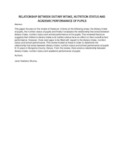DEMOGRAPHIC AND SOCIOECONOMIC FACTORS INFLUENCING ITNS USE AMONG THE JAGGERY AND TEA WORKERS IN THE PREVENTION OF MALARIA IN SOUTH MUGIRANGO SUB COUNTY, KISII COUNTY, KENYA
Date
2020-12-13Author
Omwono, Masta Ondara
Osero, Justus O. S.
Ndwiga, Taratisio
Metadata
Show full item recordAbstract
Background; This study interviewed about 209 respondents working at the Jaggery and Tea farms. More than half of respondents understudy were at risk of contracting malaria infection due to the demographic and socioeconomic factors influencing ITNs use. Published literature on demographic and socioeconomic factors that influence ITNs use among the Jaggery and tea workers in South Mugirango Sub County, Kisii County, Kenya is limited. Purpose; This study aims to establish the demographic and socio-economic factors influencing ITNs use among the Jaggery and tea workers. Methods; A descriptive cross sectional study design was used and South Mugirango was purposively selected. The study systematically and randomly selected and interviewed 209 Jaggery and tea workers on demographic and socioeconomic factors influencing ITNs use. Qualitative methods were used to investigate their demographic and socioeconomic factors on use of ITNs. Data was collected using structured questionnaire, focused group discussion and key informants interviews to obtain views. Results; A total of 209 Jaggery and tea workers were selected and interviewed; 116 (56%) males and 93 (44%) female. Over 100% of non users of ITNs were male aged between 18-28 years and singles with no formal education. Also 64.7% by occupation were tea workers and among the non users of ITNs who were found using them as tea carrying baskets. About 94.1% of non users lived in grass thatched houses this led to low level of ITNs use due to their low level of income. Education and gender were found to be positively related with ITNs use (P<0.001) respectively. Accessibility, cost and house structure were significantly related with ITNs use. Conclusion and recommendations; the study concludes that demographic and socioeconomic factors influence use of ITNs among the Jaggery and Tea workers. Therefore, the study recommends; (a) Policy review on housing so that the government can give subsidies to low income earners to improve their living conditions within their communities. (b) Education as one of the socio pillar should be enhanced as this will impart knowledge to improve ITNs use among the Jaggery and Tea workers of various age groups with emphasis on proper use.
URI
https://www.wjahr.com/admin/assets/article_issue/25122020/1609328728.pdfhttp://ir-library.mmust.ac.ke:8080/xmlui/handle/123456789/2020
Collections
- Journal Articles [411]

